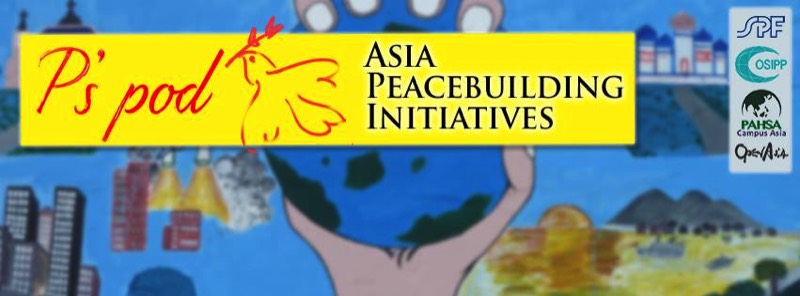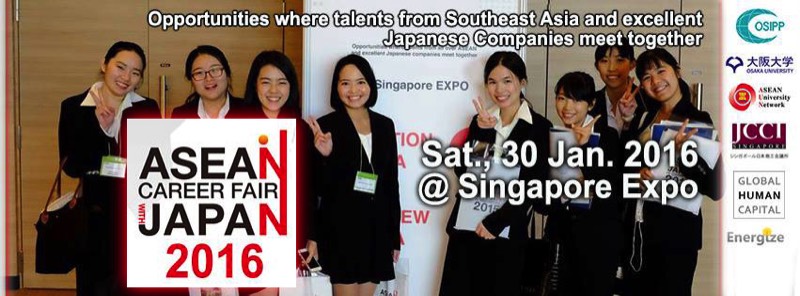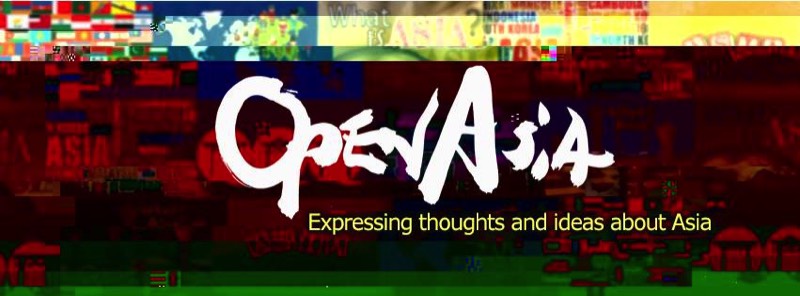The PAHSA Osaka Short Program
OSIPP, Osaka University, Japan, hosted a short-term study program for 11 international students from PAHSA consortium university partners in January 2016. It was the fifth (and last) PAHSA short program in Japan. During the program there were classroom lectures, an international symposium, and also study trips to places of interest.
Below is a day-by-day review of the program written by Jonathan Beltran, a student from De La Salle University, the Philippines.
Below is a day-by-day review of the program written by Jonathan Beltran, a student from De La Salle University, the Philippines.
Osaka Study Program Review
4 countries, 11 delegates, 1 program—Peace and Human Security in Asia, a concept that seemed so vague to many academics has now become clearer.
In the span of 11 days, the Japanese University Consortium and the Osaka School of International Public Policy (OSIPP) has become home to a diverse set of students, all eager to learn different perspectives and importantly, learn about its host country, For just over one week, Japan served as a mirror to the world’s issues such as refugees and migration, internal and external security, the indigenous people and more.
In the span of 11 days, the Japanese University Consortium and the Osaka School of International Public Policy (OSIPP) has become home to a diverse set of students, all eager to learn different perspectives and importantly, learn about its host country, For just over one week, Japan served as a mirror to the world’s issues such as refugees and migration, internal and external security, the indigenous people and more.
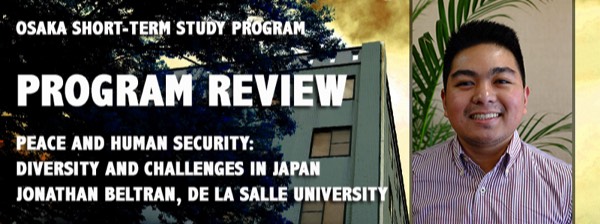
A melting pot of ideas
As we conclude today with an amazing roster of Southeast Asian students, we look back at what has taken place in the past days of the Osaka Short Program and what we have learned. Prof. Nakachi, Specially Appointed Professor of OSIPP and former Dean of Meio University pointed out that were two themes running throughout. First, Japan served as a base line for comparison for developing countries where the delegate students came from, and second, the eagerness of the students to take back home what they had learned from the program.
A brief recap of what took place on the program —
Day 1: Our day started with a breezy welcome from Prof. Matsuno, he warmly discussed the topics ahead and introduced to us the content of the program. It was followed by a lecture by Prof. Haruko Satoh about Japan’s security and modernization throughout the years, and how Japan is dependent for its external security with the United States after renouncing militarization after WWII. The lecture also discussed the post-war states and Japan’s jump to become an economic powerhouse.
Day 2: On the second day of the program, there were two lectures. One was about the rights of indigenous people in Japan, particularly, the case study of the Ainu people in Hokkaido, the second was about Japan’s accommodation in terms of the disabled. The lectures provided activities for the students to share and discuss their personal experiences in relation to the needs of those that had been marginalized.
Day 3: The lectures on day three were some of the most interesting: Japan’s rising inequality and Suicide in Japan.
Day 2: On the second day of the program, there were two lectures. One was about the rights of indigenous people in Japan, particularly, the case study of the Ainu people in Hokkaido, the second was about Japan’s accommodation in terms of the disabled. The lectures provided activities for the students to share and discuss their personal experiences in relation to the needs of those that had been marginalized.
Day 3: The lectures on day three were some of the most interesting: Japan’s rising inequality and Suicide in Japan.
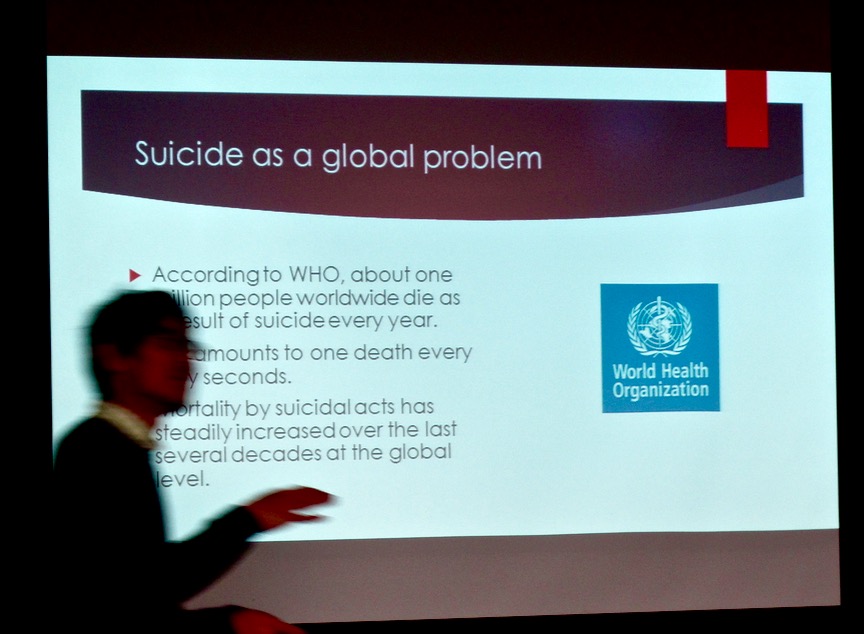
Professor Tetsuya Matsubayashi’s lecture, Suicide in Japan
We were joined on day three by students from Kyung Hee University who also provided us with many perspectives about suicide, since their country also experiences a large number of suicide related deaths. Interestingly, there were also economic explanations to suicide offered. The lecture on Japan’s inequality also provided to be contradictory to many students preconceptions, that of Japan as a power economy where nobody is left behind.
Day 4: This day, featured a very popular topic, Okinawa’s peace. Professor Takamine shared his analysis on Compensation Politics of the U.S. Military base relocation in Okinawa. It was followed by an afternoon lecture with Asst. Ando who shared with us views on a very topical issue, that of migration and refugees. We were also given a closer look as to how Japan can help with some of the world’s migration issues if it fixes its regulatory policies on them.
Day 5: On this day the classroom was outside, we went to a symposium on EU Anti-discrimination Law and Policies for Equality. It helped us focus on how we might use EU’s framework against discrimination and how it can serve as an example which might be able to be replicated in Japan and, around the world.
Day 6/7: This was one of the most exciting and exhilarating days; it was harrowing, eye-opening and enormously educational. It was already eight days since we first set foot in Osaka yet we had only seen the ‘glossy’ side. The feeling of excitement we had on our first day had never faltered, even after spending more than a week there, yet what was to come had a much harder edge.
We were taken to K-town (Korea Town), and we saw how modern day discrimination of the marginalized pre and post-war Koreans is taking place in Japan.
Day 4: This day, featured a very popular topic, Okinawa’s peace. Professor Takamine shared his analysis on Compensation Politics of the U.S. Military base relocation in Okinawa. It was followed by an afternoon lecture with Asst. Ando who shared with us views on a very topical issue, that of migration and refugees. We were also given a closer look as to how Japan can help with some of the world’s migration issues if it fixes its regulatory policies on them.
Day 5: On this day the classroom was outside, we went to a symposium on EU Anti-discrimination Law and Policies for Equality. It helped us focus on how we might use EU’s framework against discrimination and how it can serve as an example which might be able to be replicated in Japan and, around the world.
Day 6/7: This was one of the most exciting and exhilarating days; it was harrowing, eye-opening and enormously educational. It was already eight days since we first set foot in Osaka yet we had only seen the ‘glossy’ side. The feeling of excitement we had on our first day had never faltered, even after spending more than a week there, yet what was to come had a much harder edge.
We were taken to K-town (Korea Town), and we saw how modern day discrimination of the marginalized pre and post-war Koreans is taking place in Japan.
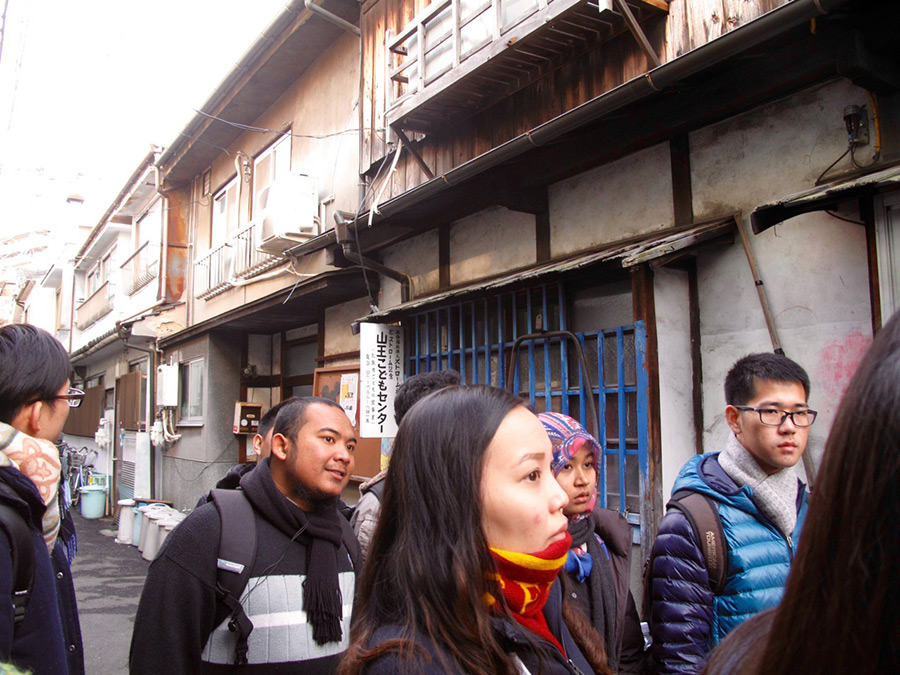
A visit to Korea Town, colloquially known as ‘Kamagasaki’
What is hard to describe however is how immersive the day was. Korea Town, colloquially called ‘Kamagasaki’ is widely regarded as an unsafe area for casual onlookers. It was here where we visited a dilapidated building used as a temporary shelter for the homeless, a place where they meet with their friends to pass the time. In the area, alcohol is also so cheap that it is used by the poor to keep warm during the winter.
Many images were striking during the visit, and yet we found out that although some people in the area look tough and life-worn, dangerous even, other things reminded us of their human values. They have soft hearts inside and many are waiting to be listened to, loved, and to feel important in society. We found out these things when we listened to one of the former homeless person and a modern-day casual laborer sharing stories of their lives. It was truly an eye-opening experience and a side a Japan very few casual visitors get to experience.
It’s been such a great and fulfilling opportunity, going to Osaka, exploring its undiscovered corners and unchartered territories. We’ve been to different places, seen a totally different culture than ours, we’ve navigated seemingly complicated train networks and walked seemingly hundreds of kilometers. Importantly, we’ve got realizations that only PAHSA can give a student; we’ve generated new frameworks for research and new ideas and passions to pursue. Thank you very much to all the professors, staff and graduate assistants who’s been with us in this journey, hopefully, the spark lit by this experience would flame us further.
Many images were striking during the visit, and yet we found out that although some people in the area look tough and life-worn, dangerous even, other things reminded us of their human values. They have soft hearts inside and many are waiting to be listened to, loved, and to feel important in society. We found out these things when we listened to one of the former homeless person and a modern-day casual laborer sharing stories of their lives. It was truly an eye-opening experience and a side a Japan very few casual visitors get to experience.
It’s been such a great and fulfilling opportunity, going to Osaka, exploring its undiscovered corners and unchartered territories. We’ve been to different places, seen a totally different culture than ours, we’ve navigated seemingly complicated train networks and walked seemingly hundreds of kilometers. Importantly, we’ve got realizations that only PAHSA can give a student; we’ve generated new frameworks for research and new ideas and passions to pursue. Thank you very much to all the professors, staff and graduate assistants who’s been with us in this journey, hopefully, the spark lit by this experience would flame us further.
PAHSA gave new ideas, passions, things to pursue —
It’s been such a great and fulfilling opportunity, going to Osaka, exploring its undiscovered corners and unchartered territories. We’ve been to different places, seen a totally different culture than ours, we’ve navigated seemingly complicated train networks and walked seemingly hundreds of kilometers. Importantly, we’ve got realizations that only PAHSA can give a student; we’ve generated new frameworks for research and new ideas and passions to pursue. Thank you very much to all the professors, staff and graduate assistants who’s been with us in this journey, hopefully, the spark lit by this experience would flame us further.
PAHSA is part of "Campus Asia." Supported by the Ministry of Education, Culture, Sports, Science and Technology in Japan
Download the PAHSA Brochure
PAHSA sister sites
.gif)
